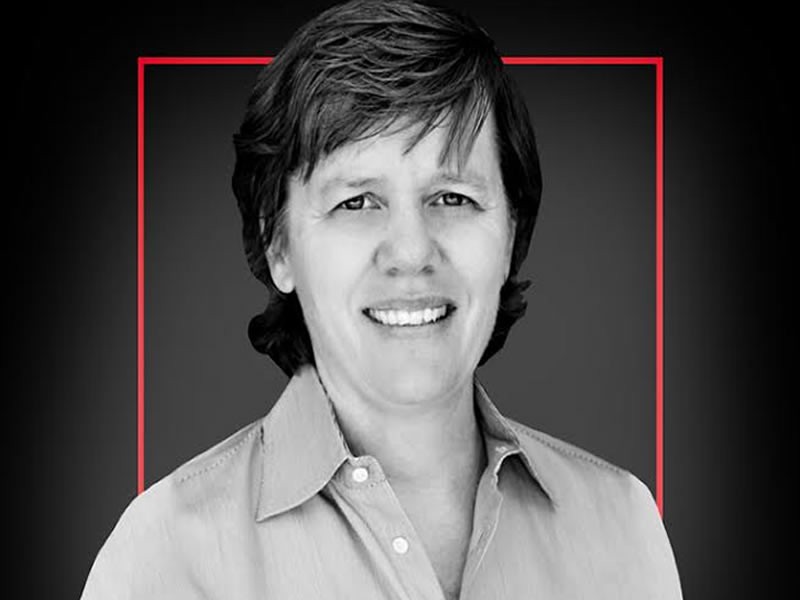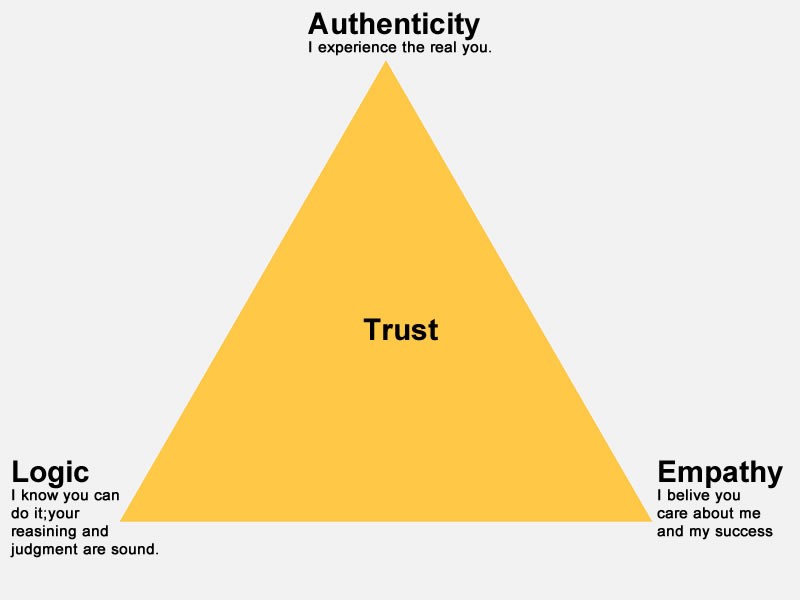Insight Blog
Agility’s perspectives on transforming the employee's experience throughout remote transformation using connected enterprise tools.
13 minutes reading time
(2687 words)
The Frances Frei Trust Triangle - It’s Workings, Examples & More
Explore the trust triangle's role in building effective, trust-based relationships in organizations and personal life.
The trust triangle, a concept pioneered by Frances Frei, is a fundamental framework for understanding and cultivating trust in both organizational and personal relationships.
Trust, an essential element in any relationship, forms the backbone of effective communication, collaboration, and overall organizational health. It fosters a safe environment where ideas flourish, risks are taken, and genuine connections are formed.
Frances Frei, a renowned thought leader in the field of leadership and trust, conceptualized the Trust Triangle as a tool to dissect and enhance the components of trustworthiness.
This article explains the workings of the Frances Frei Trust Triangle, exploring its practical application in various settings. It outlines how to implement the Trust Triangle, discusses its key components – Authenticity, Logic, and Empathy – and provides real-world examples to illustrate its effectiveness.
By dissecting this model, the article aims to offer valuable insights into building and maintaining trust, a critical aspect of successful leadership and healthy interpersonal dynamics.
Understanding and applying the principles of the Trust Triangle can lead to more robust, trust-based relationships, pivotal for personal growth and organizational success.
Understanding The Frances Frei Trust Triangle and Trust triangle framework
Detailed Explanation of the Frances Frei Trust Triangle Concept
So what is the Trust triangle framework?
The Frances Frei Trust Triangle is a model that dissects the complex concept of trust into three fundamental components: authenticity, logic, and empathy.
Authored by Harvard Business School Professor Frances Frei, this framework posits that trust in any relationship, whether personal or professional, is built on these three pillars. Authenticity refers to being genuine and true in one's actions and words; people are more likely to trust someone whose actions are consistent with their words.
Trust triangle harvard says the logic relates to the soundness of one's reasoning and knowledge; a person's ability to make rational, coherent arguments enhances others' trust in them.
Lastly, empathy involves understanding and valuing others' feelings and perspectives; showing empathy indicates a regard for others, which is critical for establishing trust.
Frei's model emphasizes that a deficiency in any one of these areas can erode trust. For instance, a lack of empathy may overshadow even the most logical and authentic actions.
The Trust Triangle serves as a guide for individuals and organizations to assess and improve their trustworthiness. By actively working on each of these elements, one can build stronger, more trust-filled relationships.
This model has gained significant traction for its practicality and effectiveness in various contexts, from leadership development to team building and customer relations.
Trust triangle example leadership, take a CEO, Sarah, who heads a technology company.
Her leadership style exemplifies the Trust Triangle:
- Competence: Sarah is highly competent in her field. She holds a strong educational background in technology, has years of experience in the industry, and stays updated on the latest trends and innovations. Her team respects her technical expertise, and her decisions are based on a thorough understanding of the business and industry.
- Reliability: Sarah is known for her reliability. She consistently meets deadlines and ensures that her team does the same. When she commits to a project, her team can trust that it will be delivered on time and with high quality. Sarah's reliability creates a sense of stability and predictability within the organization.
- Integrity: Sarah upholds a high level of integrity. She is transparent and honest in her communications with the team. When challenges arise, she openly addresses them, providing clear and truthful information. Sarah's ethical conduct fosters a culture of trust within the organization.
Enter this serach term "Trust triangle harvard business" in google search to learn more, or watch the trust triangle ted talk here.
Historical Background and Development of the Trust Triangle
The Frances Frei Trust Triangle originated from the extensive research and practical experiences of Frances Frei, a professor at Harvard Business School renowned for her expertise in leadership and trust.
The development of this model was motivated by Frei's observations of trust dynamics in various organizational and personal contexts. She noticed recurring patterns where trust, a fundamental aspect of successful relationships and effective leadership, was often compromised due to deficiencies in certain key areas.
Frei's academic and consulting work, which involved extensive interaction with leaders and organizations across different sectors, contributed to the evolution of the Trust Triangle. She identified that trust issues often stemmed from problems in authenticity, logic, or empathy. The model was further refined through her work in helping organizations address their leadership challenges and build more trusting environments.
The historical context of the Trust Triangle is rooted in the evolving understanding of organizational behavior and leadership. As businesses and institutions increasingly recognized the importance of trust in fostering a positive workplace culture and driving performance, models like Frei's offered a tangible framework to diagnose and enhance trustworthiness.
Today, the Frances Frei Trust Triangle is widely regarded as a seminal model in leadership and organizational development. Its clear, actionable framework provides a basis for individuals and organizations to understand, assess, and cultivate trust effectively, making it a vital tool in the modern leadership and management arsenal.
Relevance of the Trust Triangle in Modern Organizational Settings
The relevance of the Frances Frei Trust Triangle in contemporary organizational settings is profound and multifaceted. In today's fast-paced and increasingly digital world, where remote work and virtual interactions are common, establishing and maintaining trust presents unique challenges. The Trust Triangle provides a clear and actionable framework for navigating these challenges.
It emphasizes the importance of authenticity, logic, and empathy in building trust - qualities that are crucial for leaders and team members alike in fostering a positive organizational culture.
In an era where employee engagement and retention are key concerns, the Trust Triangle offers a blueprint for creating a trustworthy environment. This is crucial for attracting and retaining talent, as well as for enhancing team collaboration and productivity.
Moreover, in customer-facing aspects of business, the model aids in building strong customer relationships based on trust, which is essential for long-term business success.
Overall, the Frances Frei Trust Triangle remains highly relevant in modern organizational contexts, providing valuable insights and strategies for building robust, trust-based relationships in an ever-evolving business landscape.
How To Implement The Triangle of Trust?
Step-by-step Guide on Implementing the Trust Triangle
Implementing the Triangle of Trust involves a focused approach to enhancing authenticity, logic, and empathy within organizational interactions.
The first step is to conduct an honest assessment of current levels of these elements in your leadership and communication style. This can be achieved through self-reflection, feedback from peers, or even formal assessments.
Next, develop a plan to strengthen each component of the triangle.
For authenticity, this might involve being more open and transparent in your communications. To improve logic, focus on presenting clear, well-reasoned arguments and decisions. Enhancing empathy can be achieved by actively listening to others and showing genuine concern for their perspectives and needs.
Regularly practice these behaviors in your daily interactions and encourage your team to do the same. It's also important to create a supportive environment where these traits are valued and rewarded.
Finally, monitor progress and make adjustments as needed. Implementing the Triangle of Trust is an ongoing process that requires commitment and continuous effort to maintain and strengthen trust in all your relationships.
Follow us and access great exclusive content everyday: Follow us on Google News
Strategies for Building Each Component of the Trust Triangle
Building each component of the Triangle of Trust requires specific strategies.
For authenticity, focus on consistent and transparent communication. Share your true thoughts and feelings in a respectful manner, and ensure your actions align with your words. This builds credibility and trustworthiness.
To strengthen the logic component, hone your ability to present clear, rational arguments. Develop a deep understanding of your subject matter, and communicate in a way that is coherent and comprehensible. This involves being prepared, organized, and thoughtful in your approach to problem-solving and decision-making.
Enhancing empathy involves actively listening to others, showing genuine interest in their perspectives, and acknowledging their feelings. Practice empathy by putting yourself in others' shoes and responding in a way that demonstrates understanding and concern.
Each of these strategies contributes to building a strong foundation of trust.
By focusing on improving authenticity, logic, and empathy, you can effectively implement the Triangle of Trust in your personal and professional relationships.
Challenges and Solutions in Implementing the Trust Triangle
Implementing the Trust Triangle effectively can present challenges.
A key challenge is overcoming ingrained behaviors and mindsets that contradict the principles of authenticity, logic, and empathy. For instance, some individuals may struggle with being transparent due to a fear of vulnerability or negative feedback, which hinders authenticity.
Another challenge is ensuring consistency in logic, particularly in fast-paced environments where decisions are made under pressure. Maintaining a logical, coherent approach in such situations can be difficult.
Empathy can also be challenging in diverse workplaces where understanding and relating to varied perspectives and experiences may not come naturally.
Solutions include training and development programs focused on communication and emotional intelligence skills.
Regular workshops and team-building activities can foster these skills. Also, creating a supportive culture that values and encourages authenticity, logic, and empathy is crucial. Leaders should lead by example, demonstrating these qualities in their actions and decision-making.
Regular feedback and open dialogues can also help address these challenges and reinforce the principles of the Trust Triangle.
What Are The Components of The Trust Triangle?
Authenticity, Logic, and Empathy
What are the components of the Trust Triangle? They are Authenticity, Logic, and Empathy, each playing a pivotal role in establishing trust. Authenticity involves being genuine and true to oneself, which fosters credibility and reliability in relationships. It requires consistency between one's words and actions.
Logic pertains to the soundness and coherence of one's reasoning. When individuals present clear, well-thought-out arguments, they are perceived as more trustworthy. Finally, empathy is about understanding and sharing the feelings of others.
Demonstrating empathy shows care and concern for others' perspectives, which is crucial in building strong, trust-based connections. Together, these components form the foundation of the Trust Triangle, which is essential for cultivating trust in various interactions and relationships.
You may also like: Best Apps for Employees: UPDATED 2022 – A Complete Guide
The Interrelationship Between these Components
The components of the Trust Triangle – Authenticity, Logic, and Empathy – are interrelated, each reinforcing the others to build trust. Authenticity earns respect and credibility, laying a foundation for trust. However, it must be supported by logic; authenticity without rationality can lead to misplaced trust. Similarly, logic needs the warmth of empathy to be truly effective.
Logical arguments alone might seem cold or uncaring without empathetic understanding.
Empathy, in turn, is more impactful when it's genuine (Authenticity) and reasonable (Logic).
This synergistic relationship among the three components ensures a balanced approach to building and maintaining trust, making each aspect indispensable in the process.
Real-world Implications
In various organizational contexts, the components of the Trust Triangle have distinct real-world implications.
Authenticity fosters a culture of honesty and integrity, encouraging open communication and transparency, crucial in leadership and team dynamics. Logic ensures decisions and policies are rational and well-founded, building confidence among employees and stakeholders.
This is particularly vital in strategic planning and problem-solving scenarios. Empathy, on the other hand, enhances team cohesion and employee morale by creating an environment where individuals feel understood and valued.
This is essential in customer relations, human resources, and conflict resolution. Together, these components strengthen organizational trust, fostering a productive, collaborative, and positive workplace atmosphere.
Trust Triangle Example
Real-life examples or case studies
A trust triangle example is illustrated in the case of a leading technology company that restructured its leadership approach.
The company's CEO focused on enhancing authenticity by openly sharing challenges and strategies with employees, fostering a culture of transparency. The company implemented data-driven decision-making processes to strengthen logic, ensuring that all strategic decisions were well-reasoned and clear.
Empathy was emphasized through active listening sessions and feedback mechanisms, allowing employees to feel heard and valued.
This holistic application of the Trust Triangle increased employee trust and engagement, resulting in higher productivity, improved morale, and more robust organizational performance.
Successfully Implemented the Trust Triangle
Various organizations and individuals have successfully implemented the Trust Triangle, showcasing its versatility and effectiveness.
For instance, a healthcare organization emphasizes empathy by actively seeking patient and staff feedback and using this input to enhance care and workplace policies.
A tech company reinforced logic by adopting transparent, data-driven decision-making processes, thus gaining employee trust in leadership's choices.
A university leader demonstrated authenticity in the education sector by regularly communicating strategic plans and personal reflections, fostering a trustworthy and open academic environment.
These examples highlight how applying the Trust Triangle's authenticity, logic, and empathy principles can lead to stronger, trust-based relationships and organizational success.
When Trust is Lost
When any of the three components—authenticity, empathy, or logic—experiences a breakdown, trust becomes shaky and can ultimately be eroded.
In a Harvard Business Review article, authors Frei and Morriss refer to this phenomenon as the "trust wobble." Reflect on instances where trust diminished between you and a leader, or vice versa.
Can you identify the specific facet of the triangle where the wobbling occurred? Perhaps it was a failure to voice concerns aligned with your values (authenticity), a hasty decision without thorough consideration of consequences (logic), or a lack of empathy, such as being thrown under the bus in a meeting (empathy).
Personally, I've encountered trust wobbles in all three areas. Nevertheless, logic tends to be the most resilient aspect of my triangle, whereas Adam excels in authenticity. I've found the need to enhance my empathy, particularly with other team members, when logic is inclined to dominate.
As with any aspect requiring growth and transformation, the initial step is awareness. Identifying your trust wobbles serves as the foundation for rebuilding trust in your strategic partnerships or other relationships. Statistics reveal that organizations with high levels of trust are more likely to outperform their counterparts.
According to the Edelman Trust Barometer, businesses with a trust advantage have a 2.5 times higher likelihood of being recommended to others, emphasizing the tangible benefits of trust in professional relationships.
Adopt and Implement the Trust Triangle
The challenges presented by the Great Resignation in the healthcare sector emphasize the pivotal role of trust in the workplace.
Embracing authenticity, empathy, and logic—the foundational elements of Frances Frei's Trust Triangle—enables organizations to cultivate a workplace culture that nurtures trust.
Transparency is fostered through authenticity, deeper connections are formed through empathy, and informed decisions are guided by logic—all essential components for establishing and sustaining trust among employees.
The Trust Triangle framework serves as a roadmap for effectively navigating the uncertainties of the Great Resignation.
It serves as a call to action for healthcare leaders to prioritize trust as a fundamental value, demonstrating an unwavering commitment to fostering an environment where employees feel valued and heard, and where patients receive the high-quality care they deserve.
Through the adoption and implementation of the Trust Triangle, healthcare organizations can not only endure the challenges but also emerge from them more robust, resilient, and trusted by all stakeholders.
Free ebook: How To Get Your Intranet Off The Ground
Wrapping up
The Frances Frei Trust Triangle, with its components of Authenticity, Logic, and Empathy, offers a robust framework for building trust in various settings. Its relevance in today's organizational contexts is undeniable, providing a clear guide for enhancing trustworthiness.
Implementing the Trust Triangle involves addressing challenges and strategically developing each component. Real-life examples demonstrate its effectiveness in fostering strong, trust-based relationships.
By embracing and applying this model, organizations and individuals can create a more transparent, rational, and empathetic environment, leading to improved communication, collaboration, and overall success in both personal and professional spheres.
Categories
Blog
(2626)
Business Management
(321)
Employee Engagement
(211)
Digital Transformation
(175)
Intranets
(120)
Growth
(119)
Remote Work
(61)
Sales
(48)
Collaboration
(37)
Culture
(29)
Project management
(29)
Customer Experience
(26)
Knowledge Management
(21)
Leadership
(20)
Comparisons
(6)
News
(1)
Ready to learn more? 👍
One platform to optimize, manage and track all of your teams. Your new digital workplace is a click away. 🚀
Free for 14 days, no credit card required.
















